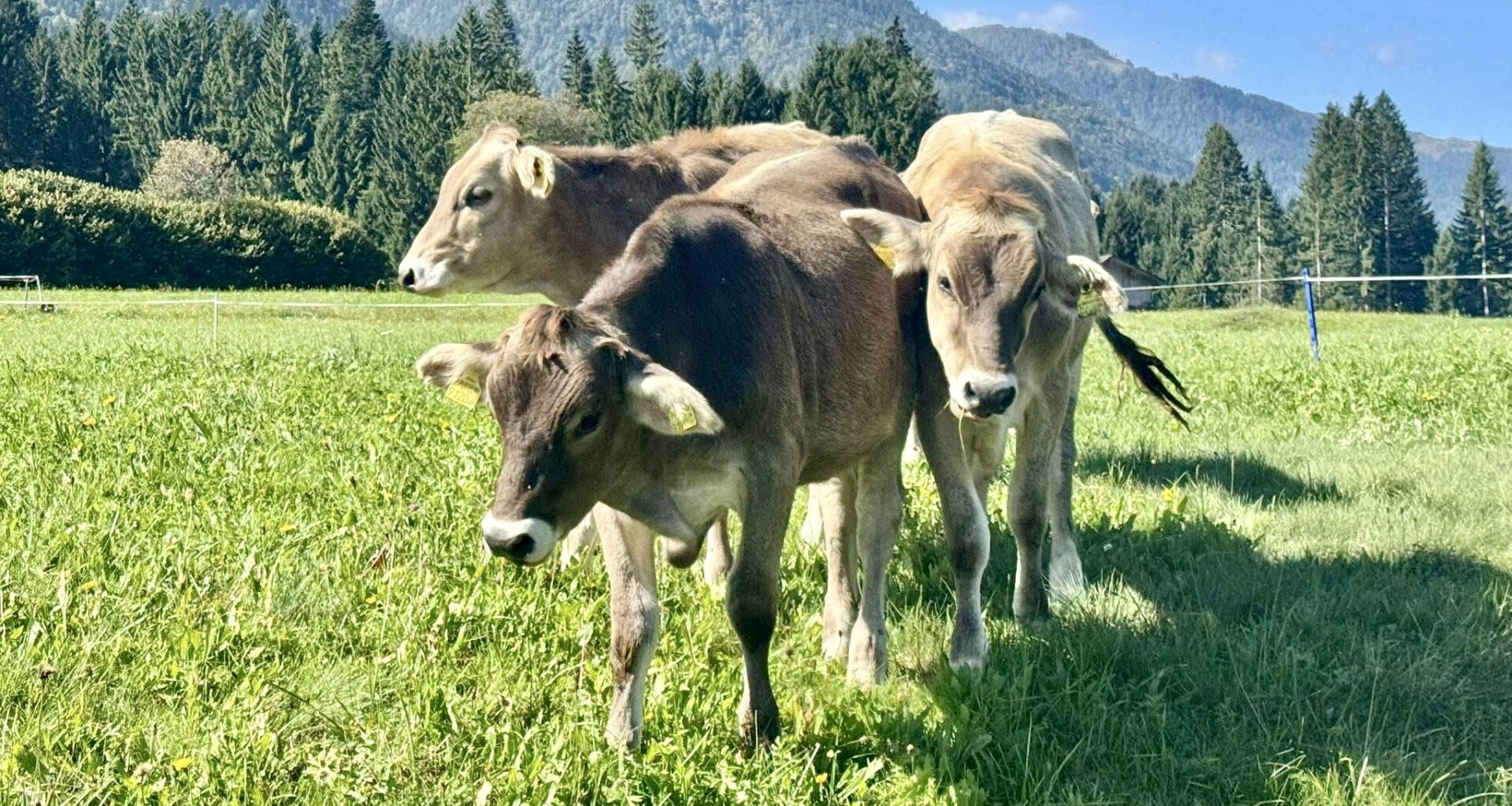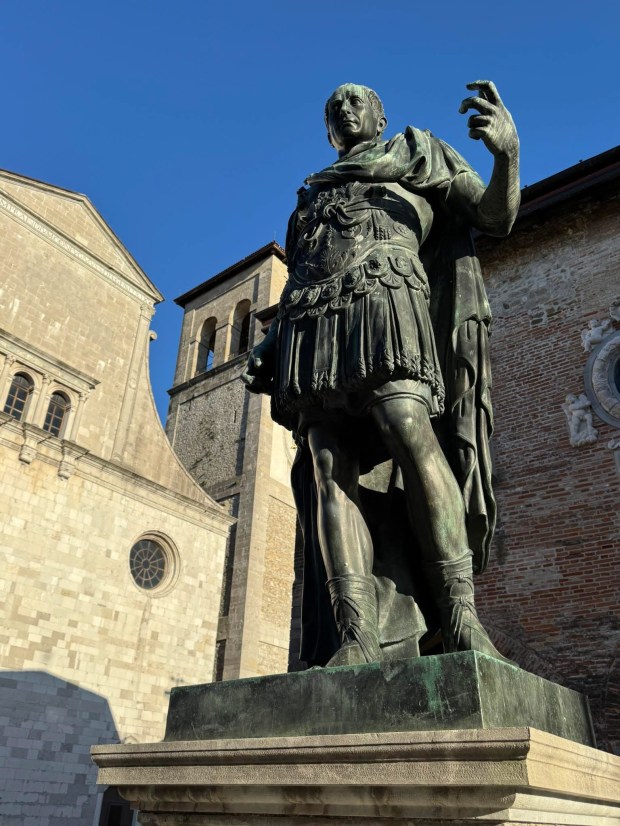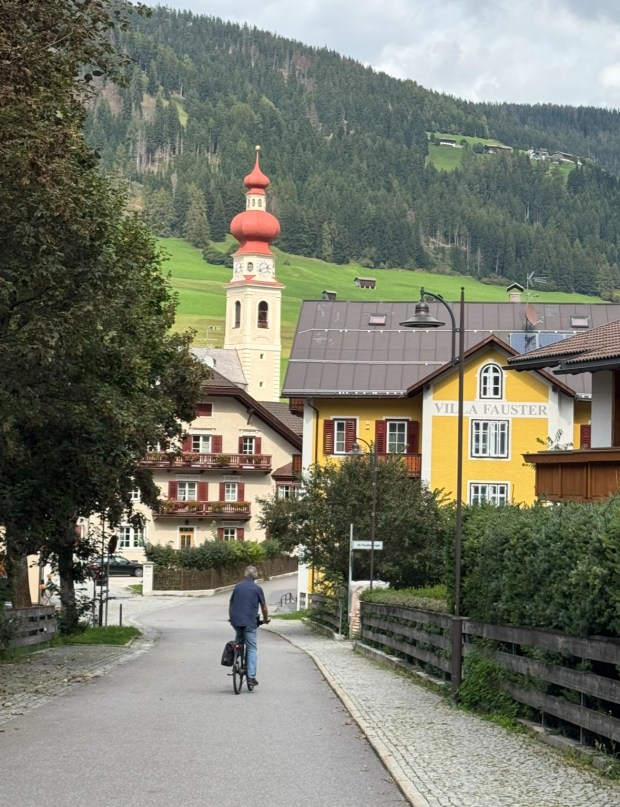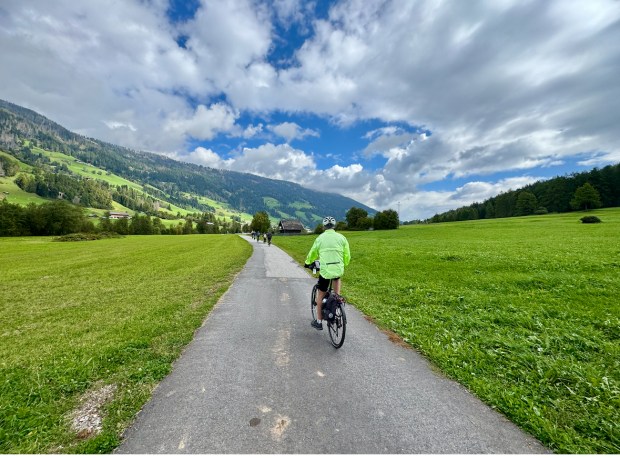
Virginia S. Mason
The weather cooperated, other than riding for a couple of hours in one torrential rain storm. Our jackets kept us mostly dry. Virginia S. Mason
The scenery exceeded expectations on our weeklong bicycle trip through the Dolomites in Italy and Austria, and the Julian Alps of Slovenia, with dramatic mountain backdrops, green valleys, castles, glacially-fed rivers and lakes.
But ours was not the most auspicious of starts.
The elevation profile for the first two days was inviting, promising little climbing, and an easy pedal along the descending watershed of the Drau River.
So why, within the first hour, were my wife and I huffing and puffing up a dirt and gravel road on the side of the mountain, deviating from the main bike path to search for the cabin of a famous 19th Century composer?
Gustav Mahler wouldn’t ordinarily entice me out of my way, but a road sign pointed to his home. Soon I was stopping to ask locals how far up the mountain and getting assurances his homestead was only 400 meters away on the increasingly steep, slippery surface.
Except we passed the entrance and continued laboring up the incline twice as far, forced to push our bikes, until we asked for direction from a family that turned us around.
My curiosity was already testing my wife’s patience and squandering our energy for the first day’s 49-mile ride. Not only that, we couldn’t get close to Mahler’s cabin. It had just closed for the season.
No problem. We cruised down the hill back to the paved path and were relaunched on our odyssey, which would eventually take us 220 miles over six days to our destination of Trieste, a northeast Italian town on the Adriatic Sea.
This would be the fifth time in seven years that we’ve done a cycling tour in Europe after previous outings along the Danube River, and in Croatia, Turkey, Portugal and Spain.
Equipped with rental bikes and a pannier to store a rain jacket, or a lunch, the tour company arranges hotel accommodations for each night and also transfers your luggage for you each day.
It’s a great way to see a country. A hearty breakfast is included. It’s self-guided with turn- by-turn directions on a phone app and you have time to explore the sights along the way and cruise through villages, all of which seem to have an ancient church and tall steeple.
For the most part our trip in mid-September was easy to navigate, with much of our route on dedicated bike paths and quiet country roads and hamlets. But some intersections and roundabouts could be tricky, as well as bike path construction projects that required a detour.
In one instance we were flummoxed by the app, when we were trying to catch a train to avoid a high mountain pass and cut out some difficult miles on the bike.
It took us to the wrong side of the station, with no choice other than to nervously walk and lift our bikes over a half-dozen railroad tracks to get to our train, with only minutes to spare.

Virginia S. Mason
The mist-covered Dolomites hover over a couple of cyclists making their way along a bike path near San Candido, Italy, a town near the Austrian border. Virginia S. Mason
But we had no other complaints. And the price was reasonable. The Dolomite trip was about $1,400 each, which included a bike upgrade and bike theft insurance. We booked the trip through BikeTours.com
For a little extra, you could get an e-bike. We chose not to, unlike most of the two dozen or so other cyclists who did the same trajectory each day, and stayed in the same hotels, but rode at their own pace.

Virginia S. Mason
Pausing in East Tyrol to look at the Gailtal Alps, sometimes considered a part of the Dolomites. Virginia S. Mason
Everyone seemed wowed by the experience.
“This was our fourth international ride, and I thought this was the best one,” said Chris Hazlett, an attorney from Salida, Colorado, who along with his wife Marcia has done bike trips in England, Vietnam, Cambodia and along the Danube.
Not only were the trails really nice and uncrowded, he said, the weather and people were pleasant.
He liked the three- and four-star hotel accommodations. “Every day’s breakfast was better than the last. And the scenery, the Dolomites. Wow, yeah, the Dolomites were spectacular,” he said.
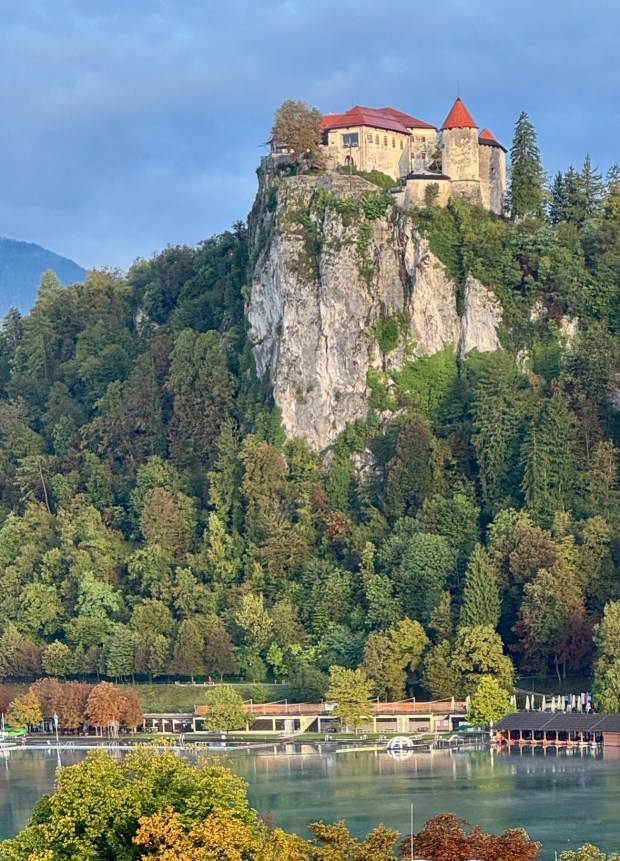
Virginia S. Mason
Bled Castle, overlooking Lake Bled in Slovenia. The medieval castle was rebuilt following heavy bombardment in World War II. Virginia S. Mason
I agreed that the 9,000-foot-high craggy Dolomites were impressive, even though they were often wrapped in mist and seen in silhouette.
My only regret is that I would have liked to have taken advantage of one of the cable cars in the area that take you closer to the peaks and high mountain meadows, where you can hike in summer and ski in winter.
Colleen Pettar, a veteran of cycling trips who lives in Avon, Minnesota, said the cycle tour was wonderful, a great escape.
“The countryside was gorgeous,” she said, “but I think we went too fast. We should have stopped more.”
She also was impressed by the kindness of strangers. When she paused at the side of the road to peel off some extra layers of cycle clothing in Slovenia, a local man came out of a vineyard and offered her some grapes.
She apologized for having nothing to give in return. “He said ‘no, no, it’s my gift.’ He expected nothing. And my feeling was, we don’t have those experiences when you arrive by car, or on the bus.”
We had taken both bus and car to get to the start of our cycling adventure, after flying to Munich, Germany, and staying a couple of nights in Innsbruck, Austria.
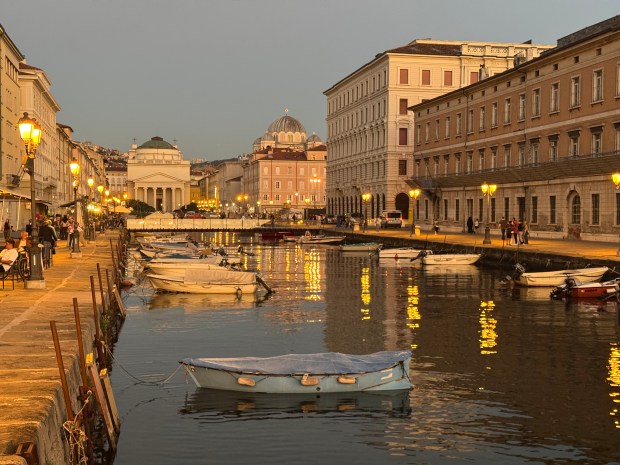
Virginia S. Mason
Trieste, Italy, at twilight. Virginia S. Mason
From Innsbruck we skipped a confusing train/ bus itinerary and splurged on a nearly two-hour Uber ride to get us to the small town of Villabassa, Italy, where we were scheduled to start cycling the next day.
Our first night there we had a superb dinner in the handsomely wood-paneled Gasthouse Adler, a South Tyrolean hotel restaurant dating back to 1600 when it was home to a nobleman and his family.
The next morning, we pushed off on our bikes, near an authentic Roman milestone, a 6-foot-high, 500-pound, cylindrical rock marker that still had a faded inscription to the emperor Decius, from around AD 250.
The stone once served as an indicator on the road through the Pustertal Valley, marking the distance to an old provincial capital.
It was a glimpse of the many historic discoveries to come over the following days as we pedaled by pastures with bell-collared cows, sheep, and horses, past medieval abbeys and monasteries.
Perhaps the richest sense of the past came in Bled, Slovenia, with its dominating castle on a steep cliff overlooking the lake, and a small church on an island where religious pilgrims have come for more than a 1,000 years.
Bled has been a fashionable spa town since the mid-1800s and today is a crowded tourist destination captured by Instagram posts.
Prior to recorded history, before the Romans, the Franks, and Goths swept over the area, there were Neolithic and Paleolithic peoples who came to Bled, with some of their burial finds and skeletons, tools and jewelry on display in the castle museum.
The castle was restored after suffering heavy damage during World War II bombardment, and it was just one reminder of the ravages of war on our journey.
We stopped at markers that commemorated the dead young men in both world wars in small towns in Italy and Slovenia.
In World War I, there were a series of battles between Italian and Austro-Hungarian armies, with Slovene conscripts drafted into the latter.
In the next war, Slovenia was carved up by both Nazi Germany and Fascist Italy and suffered even more with ethnic cleansing carried out by Nazis.
War and conquest has been a part of the region for millennia.
We pedaled into the Cividale del Friuli, founded just over the Slovenia-Italian border by Julius Caesar more than 2,000 years ago and now a UNESCO World Heritage site distinguished by its medieval center.
A glass of draft beer never tasted so good as at the end of that hot day’s work. Nor did the Italian chocolate, and salted caramel gelato ever taste richer.
Coming into our final destination of Trieste provided for a thrilling descent along the coastal road, lined with villas and views of the sparkling Adriatic. But it also was harrowing, trying to find our downtown hotel while dodging lumbering buses and buzzing motorbikes.
We spent an extra night in Trieste with its 19th Century buildings and bustling café-restaurants flanking a grand canal. It was worth it to experience some unexpected cultural attractions, including an exhibition on the world’s great lover, Giacomo Casanova, showing his influence in art, film, literature and advertising.
The other was an exhibit on the life of J.R.R. Tolkien, marking the 50th anniversary of the Italian translation of his book, The Hobbit, along with the subsequent translation of Lord of the Rings. (Fun fact, Tolkien’s books are the most read in the world behind the Bible and the Koran.)
That extra day also allowed for an added therapeutic benefit. I located a deep massage, Thai practitioner — to kneed my tired legs.
You can reach Clark Mason at clarkmas@sbcglobal.net
